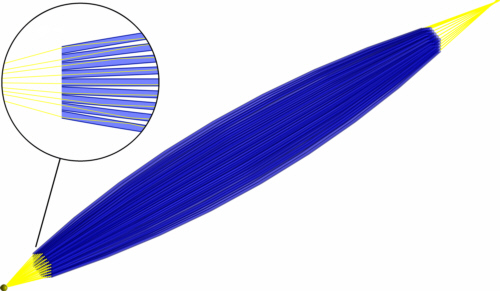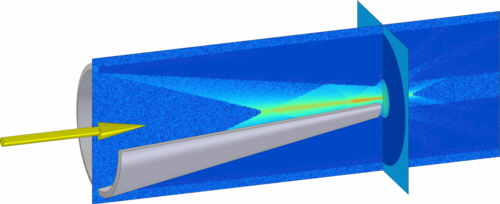Capillary optics mostly consist of glass capillaries. The X-rays are reflected in the capillaries once or many times redirecting the light to the focal plane. Table 1 gives an overview over typical parameters of capillary optics.
| Parameter | Symbol |
Typical values |
Comment | |
| mono capillary |
poly capillary | |||
| Beam diameter |
du or |
0.01-20 mm | 0.1-20 mm | |
| Focal spot diameter | dcapillary | 0.25-1000 µm | 6-1000 µm | |
| Entrance diameter | D1 | 0.01-20 mm | 0.1-20 mm | |
| Exit diameter | D2 | 0.01-0.2 mm | 0.1-20 mm | |
| Radiant intensity increasing | KΘ | 5-50 | 10-100 | KΘ=τ(ΔΘE/ΔΘA)2 |
| Capillary length | Lcapillary | 10-1000 mm | 10-1000 mm | |
| Entrance working distance | rcap,1 | ∞-0.1 mm | ∞-3 mm | |
| Exit working distance | rcap,2 | 0.1-∞ mm | 3-∞ mm | |
| Entrance angle acceptance | ΔΘE | 0.01-0.25 rad | 0.01-0.25 rad | ΔΘE=2 arctan(D1/(2r1)) |
| Exit angle divergence | ΔΘA | 0.01-0.25 rad | 0.01-0.25 rad | ΔΘA=2 arctan(D2/(2r2)) |
| Divergence of a quasi-parallel beam (for poly half capillaries) | ΔΘA | 0.0005-0.001 rad | 0.001-0.005 rad | |
| Intensity gain | K | 5-1000 | 500-20000 | |
| Spectral transmission | τ(λ) | 0.1-0.9 | 0.05-0.6 | |
Table 1: Typical parameters of capillary optics [VDI 2009b]
Poly capillary optics
In poly capillary optics (also called Kumakhov-lenses) X-rays are guided in a bundle of narrow glass capillaries by total external reflection (TER) (fig. 1) [Kum 1992]. The capillaries in the bundle are bend in a way that one side of each capillary is pointing to the X-ray source and the other side is pointing to the focus area. Poly capillary optics do not image the source point to a focus point in the sense of optical imaging: light entering the capillaries with a certain divergence angle is guided to the end of the capillary, where it leaves the capillary with an unchanged divergence angle. Consequently the light spreads out on its way from the end of a capillary to the focus area. So these optics are illumination optics.

Fig. 1: Concentrating X-rays using a poly capillary optics, photograph of a poly capillary on mouseover 
Mono capillary optics
In mono capillary optics X-rays are guided in a single glass capillary by total external reflection (fig. 2). The inner side of the mono capillary has got a rotational elliptic or rotational parabolic geometry. The source is positioned in one of the two focal points of the ellipse respectively in the focus point of the parabola. The light is redirected to the second focal point in case of the elliptical geometry respectively is collimated in case of the parabolic geometry. Focusing an incoming beam parallel to the optical axis is also possible. In both cases the light undergoes a single reflection at the inner side of the mono capillary.

Fig. 2: Mono capillary, lost rays marked red on mouse-over 
Tapered capillary optics
Tapered capillary optics consist of a slightly conical tube with very smooth inner surface.The maximum cone angle is limited by the maximum angle of total external reflection for the material and photon energy used. The incoming light is reflected one or more times at the inner surface of the tube, mostly by total external reflection in a glass capillary, but other materials would be fine as well. There is no precise focus point, more like a line of increased intensity along the optical axis (fig. 3; the tapering is largely overdrawn). These optics are simple, but have the disadvantage of providing very small working distances and do not have any imaging qualities.

Fig. 3: Tapered capillary with simulated intensity distribution 
| [Kum 1992] | M. A. Kumakhov and V. A. Sharov, A neutron lens, Nature vol. 357, pp. 390-391, DOI: 10.1038/357390a0, 1992 |
| [VDI 2009b] | VDI/VDE 5575 Blatt 3: 2009-02 Röntgenkapillaren (X-ray optical systems; Capillary X-ray optics), Berlin, Beuth Verlag, 2009 |


